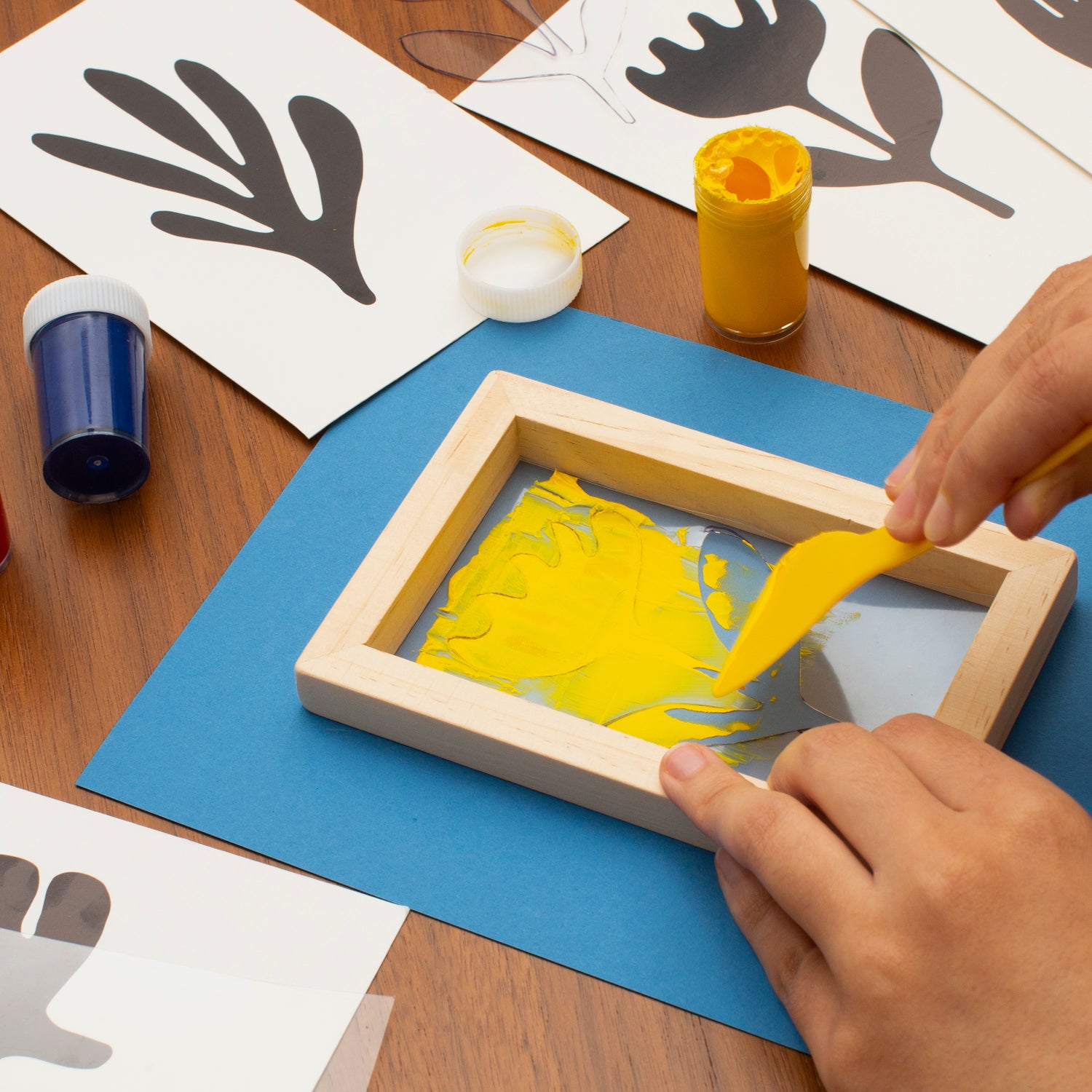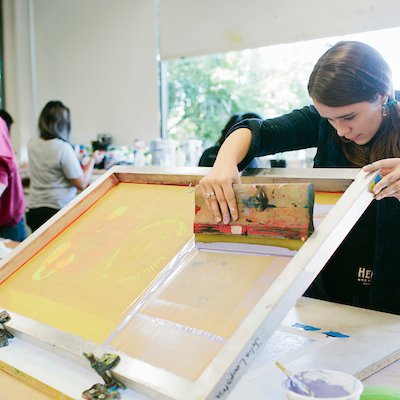ChatGPT said: How 10:9 Design Abilene is empowering creators
Wiki Article
Discover the Various Kinds of Screen Printing Techniques for Your Next Task
Screen printing uses a diverse series of strategies that can improve any kind of imaginative job. From traditional methods like serigraphy to modern innovations such as direct-to-garment printing, each technique has its special advantages. Specialty choices, consisting of environment-friendly and metal inks, present also a lot more possibilities. Comprehending these techniques can substantially affect the last result. The difficulty exists in picking the most ideal method for details needs and wanted results. What variables should one think about?
The Basics of Screen Printing
Screen printing may appear facility, it is fundamentally a straightforward process that involves transferring ink through a mesh screen onto different surface areas. The strategy begins with the production of a stencil, which defines the design to be printed. This pattern is affixed to a mesh screen, usually constructed from polyester or nylon. When the pattern is in area, ink is put on the screen and pressed with the mesh utilizing a squeegee, causing the wanted pattern being printed on the underlying product.Screen printing can be performed on a large range of substratums, consisting of paper, plastic, and textile, making it a functional selection for different jobs. The process enables vibrant colors and detailed styles, making it preferred in industries such as advertising and marketing, art, and fashion. Comprehending these basics furnishes individuals with the foundational understanding needed to check out more sophisticated methods in screen printing.
Traditional Screen Printing Techniques
Conventional screen printing methods have been employed for centuries, maintaining the craftsmanship and creativity of this method. This strategy makes use of a mesh screen to move ink onto a substratum, such as material or paper, enabling for long-lasting and lively designs. The procedure starts with creating a pattern, which obstructs specific locations of the screen to manage where the ink will be applied.One prominent method is serigraphy, typically used for restricted versions and imaginative prints. An additional is making use of water-based inks, which are environment-friendly and offer a soft feeling on fabrics - 10:9 Design reviews. Additionally, conventional approaches can include manual printing, where artisans apply ink with a squeegee, making certain accuracy and focus to information
These techniques stay valued in the industry for their responsive quality and the unique textures they create, interesting both makers and customers that value the heritage of screen printing.
Digital Screen Printing Innovations
As the need for faster manufacturing and modification in the printing market has actually risen, electronic screen printing developments have arised as a game-changer. This technology blends standard screen printing techniques with electronic processes, enabling for quick prototyping and elaborate styles that were formerly difficult to accomplish. One substantial improvement is the intro of direct-to-garment (DTG) printing, which promotes top quality, full-color prints on different textiles without the demand for displays. Additionally, innovations in ink formulations have led to eco-friendly choices that preserve vivid colors while minimizing environmental impact. Using automated systems better simplifies manufacturing, reducing labor expenses and improving accuracy. These innovations not just deal with little batch orders and customized layouts however also enable quicker turnaround times, making them ideal for services concentrated on conference consumer needs in a hectic market. Digital screen printing, subsequently, stands for an essential evolution in the domain name of printing techniques.Specialty Screen Printing Methods
Discovering specialty screen printing methods exposes a varied selection of methods that push the limits of imagination and performance in the printing market. Among these, glow-in-the-dark inks supply an one-of-a-kind aesthetic effect, making layouts come alive in low-light conditions. Metallic inks, understood for their sparkling finish, add a touch of high-end to published products. One more innovative method is discharge printing, which removes color from the textile as opposed to including ink, leading to a soft, vintage feel. High-density printing creates an increased appearance on the surface area, boosting tactile interaction. Additionally, water-based inks are obtaining appeal for their dynamic colors and decreased environmental effect. Each of these specialized strategies accommodates certain style needs, allowing musicians and brand names to develop standout items that reverberate with their audiences. By leveraging these techniques, services can elevate their screen printing jobs to brand-new elevations, ensuring unforgettable impressions.Eco-Friendly Screen Printing Options
Environment-friendly screen printing alternatives are acquiring traction as the sector shifts towards sustainability. Lasting ink options and making use of naturally degradable materials are key elements in lowering the environmental impact of the printing procedure. By adopting these methods, screen printers can add to a more sustainable future while maintaining high-grade outcomes.Lasting Ink Options

Biodegradable Materials Use
As the screen printing industry advances, the unification of biodegradable materials is ending up being progressively important for eco aware methods. Developers and makers are currently discovering inks and substrates made from all-natural, renewable energies that decompose extra effectively than typical equivalents. These eco-friendly choices minimize plastic waste and decrease environmental influence, straightening with the expanding need for lasting products.
Common examples consist of water-based inks and natural cotton fabrics, both of which reduce dangerous chemicals and advertise eco-friendliness. Brand names that adopt these materials commonly boost their market charm, bring in consumers that prioritize sustainability. As recognition of ecological problems continues to rise, the shift in the direction of naturally degradable products in screen printing is most likely to acquire momentum, cultivating a greener sector criterion.
Selecting the Right Strategy for Your Job
Exactly how can one figure out the most ideal screen printing strategy for a particular task? The choice rests on several variables, consisting of the product to be printed on, the intricacy of the layout, and the desired production quantity - 10:9 Design LLC Company. Direct-to-garment printing is excellent for intricate designs with countless colors, while typical screen printing succeeds for larger runs of less complex graphics.
Furthermore, factor to consider of the end-use of the published product is important. For exterior applications, techniques that supply sturdiness and weather resistance, such as plastisol ink, may be preferred. Conversely, environmentally-conscious tasks might gain from biodegradable materials or water-based inks.
Inevitably, recognizing the project's unique requirements enables for an enlightened option, making sure both aesthetic charm and useful longevity. By assessing layout complexity, product compatibility, and production range, one can properly choose one of the most suitable screen printing method to meet their project's objectives.
Regularly Asked Inquiries
What Is the Background of Screen Printing?
Screen printing stemmed in ancient China around 1000 ADVERTISEMENT, developing through Japan and Europe. By the 20th century, it came to be popular in business art and fashion, revolutionizing exactly how styles were generated and dispersed globally.
How Do I Prepare Artwork for Screen Printing?
To prepare art work for screen printing, one need to ensure high resolution, make use of a suitable shade mode, create separate layers for each shade, and convert message to details, ensuring compatibility with the printing process and preferred outcome.What Materials Are Best for Screen Printing?
The most effective products for screen printing include top notch inks, resilient screens, and suitable substrates like cotton, polyester, or blends. In addition, using proper emulsion and mops can boost the printing procedure and results.Can I Screen Print in the house?
Yes, screen printing at home is possible. With the appropriate products, arrangement, and strategies, individuals can create high-grade prints. However, cautious consideration of work space and tools is important for effective outcomes.
What Prevail Blunders in Screen Printing?
Common errors in screen printing include incorrect exposure times, inadequate ink uniformity, misalignment of screens, not enough cleansing of products, and neglecting to check prints. These mistakes can compromise the high quality and accuracy of the last item.Screen printing might seem facility, it is basically a simple process that includes transferring ink via a mesh screen onto different surfaces. As the demand for faster production and customization in the printing industry has risen, electronic screen printing innovations have actually emerged as a game-changer. Exploring specialized screen printing approaches discloses a diverse variety of techniques that press the limits of imagination and capability in the printing industry. The finest materials for screen printing consist of top notch inks, resilient screens, and appropriate substratums like cotton, polyester, or blends (10:9 Design near me). Common mistakes in screen printing consist of improper exposure times, inadequate ink consistency, misalignment of displays, not enough cleansing of materials, and neglecting to evaluate prints
Report this wiki page